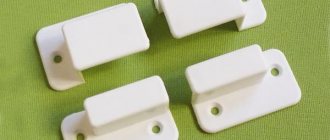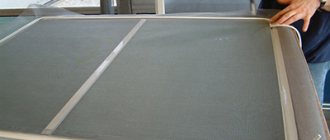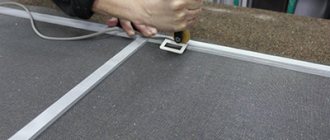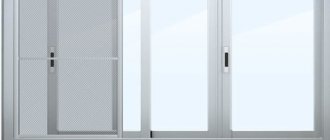mark_kr
27750 0 1
mark_kr September 21, 2016Specialization: professional in the field of construction and repair (full cycle of finishing work, both internal and external, from sewerage to electrical and finishing work), installation of window structures. Hobbies: see the column “SPECIALIZATION AND SKILLS”
The structure can be attached in a variety of ways
Attaching a mosquito net to plastic windows is usually performed at the final stage of installation: this part has a very simple design and is installed without any particular difficulties. And yet, if you do the work yourself, then it’s definitely worth understanding the nuances of choosing the type of fastening and the method of fixing the product on the window.
Purpose of the mosquito net
The mosquito net is a plastic cellular fabric stretched over a lightweight PVC profile structure. The size of its cells varies from 0.6 mm to 1.2 mm, which provides protection against flying insects trying to enter the room. The name of a modern mosquito net only partially explains its purpose. The design, unnoticeable from the inside and outside, makes the windows and balcony doors of apartments in multi-storey buildings safe for pets and birds. In addition, the fine-mesh fabric helps to effectively retain pollen and plant fluff, various debris and partly dust, which allows you to create a comfortable atmosphere in the house, especially for those who are susceptible to allergic reactions.
-And who is this? -And this is me. -Well done!
1. Making a frame: insert the corners into the frame profile. If the corners are tight, then carefully tap them, for example, with a straightening hammer, so as not to damage them.
2. Insert the impost fastening into the crossbar on both sides.
3. Place a crossbar in the middle of the length of the frame.
4. We fix the handles for the mosquito net into the groove of the frame profile 1-2 cm below the crossbar.
5. Now we need a square. We apply one side to the cross member and the other to the frame profile. Thus, we fix the angle at 90 C and eliminate the distortion of our design.
6. Place the mesh on top. An overlap of 5-10 cm on all sides is sufficient.
7. Take a rubber cord. The length of the cord should be 5 - 10 cm greater than the length of the perimeter. We step back from the edge of the frame width 5 cm and begin using a roller to roll the cord into the recess on the frame profile around the perimeter. Be sure to make sure that when rolling there are no “tightening” on the canvas or distortions in the diagonal of the frame.
9. Trim the excess length of the cord so that its edges fit butt to end.
10. Use a screwdriver to tighten the cord in the corners for security.
11. Using a construction knife, trim off the excess fabric along the outer line of the cord.
12. Our grid is completely ready.
13. We rejoice at the result, but don’t forget to clean up our workplace!
Types of holders and fastenings
Depending on the design features of the windows, the mosquito net can be secured using the following holders:
- loops;
- flags;
- pockets;
- Velcro.
There are several more options for fixing the mesh fabric in the window opening using various types of fastenings:
- plunger;
- based on the principle of roller blinds;
- according to the “accordion” principle.
Z-brackets
Structurally, this type of bracket is a zigzag-shaped strip of steel or plastic 2 mm thick. Its working planes are bent at an angle of 90⁰ relative to the base, up and down. Z-shaped brackets are screwed into the perforation holes with self-tapping screws to the window frame - 2 at the bottom and 2 at the top. At the same time, fix the frame between the fasteners into the trim on the window frame profile from the street side.
cloth
The main thing for a home-made mosquito net is to choose the right cloth. The maximum possible mesh size is 3.7 x 3.7 mm . If the cells are larger, insects (in particular, mosquitoes) will easily overcome this barrier. As for the minimum dimensions, they can be limited only by the conditions of air and light transmission for residential premises. On a balcony, for example, if the ventilation regime is observed, nets with a mesh size of 2 x 2 mm will work perfectly.
Where you have to escape exclusively from mosquitoes (say, in central Russia), a mosquito net with a mesh size of 3 x 3 mm will be reliable protection. And in Siberia, where midges plague people in cities and villages, smaller barriers will be required - mosquitoes 2 x 2 mm and smaller. If we talk specifically about the anti-dust “defense” of a home, then only a mesh with a cell of 1 x 1 mm can help.
Note! Some “the old fashioned way” choose to create an anti-mosquito net for a window using fiberglass (another name for fiberglass) with a PVC coating, but this is not the best solution, since the material, although durable, demonstrates very low light and air permeability. In addition, its thick threads are destroyed quite quickly under the influence of ultraviolet radiation coupled with dust. As a result, the mosquito net turns into a dust collector, which itself “dusts” with tiny fiberglass needles. In fact, such a mesh must be replaced every season, which is completely unprofitable.
It is better to choose a more modern, reliable and environmentally friendly polyester fiber to create a mosquito fly with your own hands . It is available with cells of various shapes and sizes - you can choose the one that suits each specific case. For example, material with rectangular cells is durable and cheap, and perfectly repels street dust without accumulating it. However, such a cell does not transmit air and light very well, so manufacturers offer a similar material, but with a hexagonal-shaped cell (1.5 mm in diameter), which also resists air and light flows, like braided fiber with a cell size of 2.7 x 2.7 mm. That is, with this option there will be much more light and air in the house, with high-quality protection of the room from dust and insects.
And yet, to make their own mosquito nets for windows, consumers most often purchase polyester fiber with rectangular cells, choosing from the following options:
- Mesh type “Standard” with normal strength and cells 3 x 3 mm.
- Anti-dust material with mesh options of 1 x 1 mm and 1.5 x 1.5 mm, having a smooth, dust-reflecting structure. This fiber is intended for use in southern regions without forests, with a high degree of insolation and air dust. It can also work as an anti-nasal protective net in populated areas of the taiga and tundra.
- Anti-cat mesh of increased strength with a mesh size of 2.5 x 3.5 mm. It is usually used as a second layer on a mesh that protects against mosquitoes and midges. It protects from the increased attention of pets from the inside and/or outside. It prevents them from damaging the mosquito and injuring themselves. Withstands the antics of cats (and even dogs) of medium size and an average degree of violence, as well as small domestic rodents, decorative mice and rats, and guinea pigs.
Features of fastening installation
Modern apartments have wooden, plastic and aluminum structures. Installing fasteners on different types of windows has some peculiarities.
For plastic windows
Most often, when installing mosquito nets on plastic frames, 4 types of fasteners are used:
- Z-shaped fastener.
- Plastic corners.
- Flag fastening.
- Plunger fastening.
Fasteners are mounted outside the windows.
For wooden windows
The mount for the frame mosquito net on wooden window frames is fixed somewhat differently. Most often, mosquitoes are attached to such window structures using metal or plastic corners and z-shaped brackets. These parts are secured to a wooden frame with self-tapping screws from the street side. Keep in mind that Z-shaped fasteners and angles are not suitable for old wooden windows that were installed deep into the window opening. In this case, it is preferable to use a frameless mesh fabric. It is glued to the frame using glue or Velcro tape. In addition, plunger fastenings are used for this purpose.
For aluminum profile windows
Mosquitoes are installed on pockets on aluminum window structures. Moreover, the fasteners in this case are fixed with aluminum rivets.
Net care
Anti-mosquito structures can be installed on a variety of types of fastenings, but still, when using them, you should adhere to very specific recommendations:
- The mesh fabric loses its elasticity over time and therefore breaks even under minor mechanical loads. Perforated fabric copes with its functions much worse, so it should be changed periodically (every five to six years).
- To extend the service life of the canvas, the nets should be dismantled for the winter period. I usually remove structures in October and put them back in place in March. Thanks to this, neither the profile nor the canvas are subject to freezing, and therefore last an order of magnitude longer.
For the winter, remove and clean the products
- After removing the structure, it is worth washing it - during the warm season it collects an incredible amount of dust. If your windows overlook a highway, then I would advise washing the screens more often - once every two to three months.
- Finally, keep in mind that this design is not designed for fall protection. Not a single mount can withstand a significant weight load, so if you have children or active pets in your home, then the sash with an installed mosquito stack can only be opened in the folding position.
I never tire of repeating: to protect children from falling, the opening of the window must be blocked. To do this, install either a special handle with a key or a lock on the bottom of the frame. It doesn’t interfere with ventilation, but it will protect you from turning the sash with overly curious hands!
"Anti-cat" is not a panacea, but it can help
- The only exceptions are anti-cat nets, which are distinguished by reinforced fabric and more reliable fasteners. But even they cannot support the weight of a well-fed Maine Coon or a small child, so it’s better to play it safe without getting into trouble!
Installation of a sliding mosquito net
Mosquitoes are mounted on sliding windows using guides. To fix it, rollers and runners are used, which ensure free movement. The design of the sliding mesh consists of two frames, internal and external. By frame we mean an aluminum profile. Rail guides are attached to the outer frame with self-tapping screws at the top and bottom. Rollers are attached to the inner frame with a stretched mesh fabric at the bottom and top. The inner frame is inserted into the guides of the outer one. The assembly of this design ensures the mesh moves smoothly during opening. Sliding mosquito nets are the best option for windows on loggias.
Did you manage to solve your problem using the recommendations from the article?
Yes!
46.45%
No. More answers required. I'll ask in the comments now.
38.48%
Partially. There are still questions. I'll write in the comments now.
15.07%
Voted: 803
Types of window screens
All those grids that manufacturers offer users can be divided into:
- swing;
- sliding;
- pleated (gathered with an accordion);
- and roll mesh roller blinds.
Pleated nets and roller blinds are the most compact and do not require removal for the winter.
Any of the above industrial designs is quite expensive and technically complex. You need hinges, you will need special locks and mechanisms. You won’t even be able to install them yourself; this requires skills, experience and special tools.
It’s easier and cheaper to make a mosquito net yourself. But this will be a fixed frame or frameless option, which, of course, will not open/close, but is guaranteed not to allow a single mosquito into the room, and will delay the penetration of fluff, dust and dirt.
The frame mesh can be external or internal, as well as insertable. In a frameless version, such a design can only be internal.











